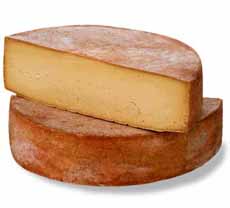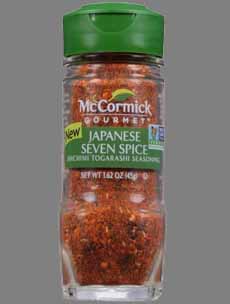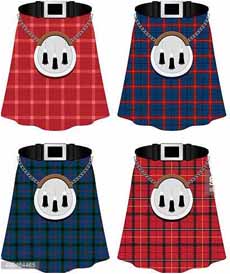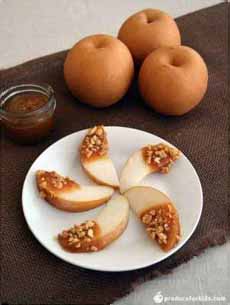
[1] Scraping melted raclette cheese onto the plate (photo courtesy Zuercher Cheese | Tumbler).

[2] A cheese melter, used in restaurants and in homes of enthusiasts (available at Raclette Corner).

[3] A home raclette grill from Swissmar, available on Amazon and elsewhere.

[4] Pouring cheese from a Swissmar grill pan (photo courtesy Swissmar).

[5] A wheel of raclette (photo courtesy The Swiss Bakery Online).
|
|
Many people like melted cheese. If you’re one of them, dish up some raclette.
Raclette (rah-KLETT) is a Swiss mountain cheese (see below), and also the name of a melted cheese dish made with it. The dish is an Alpine cousin to Welsh rabbit (not rarebit), and a reverse of the technique of that used for fondue.
With Welsh rabbit and fondue, other ingredients are mixed in with the cheese (wine or beer, seasonings). Raclette is pure melted cheese, poured over a plate of crusty bread and other accompaniments.
Originally, the wheel of Raclette cheese was heated by the fire, then scraped onto crusty, dark bread on the diners’ plates. The name derives from racler, the French word for “to scrape off.”
In modern times, restaurants have created devices that hold the wheel in position under a heat lamp, so that the cut surface melts (photo #2).
The melted cheese is then scraped from the wheel, onto a plate laden with bread, small boiled potatoes, cornichons, pickled onions, and dried meats like jambon cru (dried cured ham) and salami (photo #1).
The popularity of the dish generated home grills that make it festive to serve raclette (photo #3).
In another evolution of the dish, vegetables, shrimp, sausage, whatever, can be grilled on the top of the grill, as individual pans (coupelles) of cheese melt underneath. The grilled food is then plated, and the pan of melted cheese is then poured over it (photo #4).
DO YOU NEED A SPECIAL DEVICE?
The devices provide ambience, but of course you can simply melt the cheese in a double boiler (ideal) or a pot over low heat, whisking regularly.
A pot with a lip is ideal for pouring.
If you have a brazier (the stand for a fondue pot, with a holder for Sterno underneath), definitely use it to keep the melted cheese warm at the table.
ABOUT RACLETTE CHEESE
Raclette is a Swiss mountain cheese, most commonly used for melting. It is made from raw cow’s milk and fashioned into relatively small wheels, about 10 inches in diameter and 13 to 17 pounds (some mountain cheese wheels can be as large as 80 pounds.
Wheels are aged from 4 months up to a year.
The milk comes from two different breeds of cows, Ehringer and Fribourgeois, combined to add a more distinctive flavor to the cheese.
The washed rinds are rough, hard and dark beige in color (photo #5). The paste is pale yellow; the flavor is fruity, creamy and “melt-in-your mouth,” which is why it is such a good melting cheese.
As a washed rind cheese, the aroma of the cheese is pungent when heated.
Trivia: There are actually four cheeses known as Raclette cheeses: Bagnes, Conches, Gomser and Orsières. The different names refer to the locations of the cheesemaking dairies. The name of the village is molded into the cheese’s rind. All four cheeses have the A.O.C. designation.
RACLETTE HISTORY
Raclette, the cheese, is mentioned in medieval writings in texts from Swiss-German convents dating from as early as 1291 [source].
Served melted with black bread, it was originally fare for peasants in the mountainous Alpine regions of Valais, Switzerland and Savoie and Haute-Savoie, France. In the German-speaking part of Switzerland, it was called Bratchäs, roasted cheese.
Traditionally, cow herders carried the cheese with them as they were moving the cows to or from the pastures up in the mountains. In the evening, the cheese would be placed next to a campfire for softening and scraping onto bread.
As the dish evolved to an indoor dinner, the bread was joined by small boiled potatoes, gherkins, pickled onions, and dried meats such as jambon cru (like prosciutto) and salami.
|
|
Accompanying drinks included Kirsch (the fruit brandy also used to make fondue), herbal tea or other warm beverage, or Fendant, a local white wine.
In addition to local white wines, Riesling and Pinot Gris from the Alsace region of France have become popular pairings. A local tradition (myth) cautions that drinking water will cause the cheese to harden in the stomach, leading to indigestion (no doubt an excuse to drink more wine).
WHAT IS A MOUNTAIN CHEESE?
Also called Alpine cheeses, the term “mountain cheeses” refers to large, firm wheels made in the Swiss and French Alps.
The wheels are well-aged and full-flavored, often sprinkled with eyes (holes) ranging from small to large.
Appenzeller, Emmental, Gruyère, Hoch Ybrig, Raclette, Sbrinz, Stanser Fladä, Tête de Moine and Vacherin Fribourgeois are examples of Swiss mountain cheeses. They are semi-hard cow’s milk cheeses.
According to Caseus Montanus, an international association of mountain cheese producers, a mountain cheese is one produced and aged above 800 meters (approximately 2500 feet altitude).
Mountain cheeses are not restricted to Switzerland, but in any mountains.
Most mountain cheeses are made in France, Italy, Spain and Switzerland, but any mountainous level works. In the U.S., mountain cheeses are made in Colorado and Vermont.
According to ArtisanalCheese.com, scientific studies on the flavor profile of mountain cheeses have found as many as 100,000 micro-organisms in the flora of the high altitude mountains, as compared to fewer than 10,000 microorganisms in lower prairie altitudes. This intensity of micro-organisms is responsible for the deep and complex flavors of mountain cheeses.
|


















